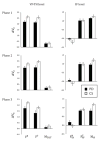Prehension synergies and hand function in early-stage Parkinson's disease
- PMID: 25370346
- PMCID: PMC5729890
- DOI: 10.1007/s00221-014-4130-7
Prehension synergies and hand function in early-stage Parkinson's disease
Abstract
We explored the multi-digit synergies and hand performance in object manipulations and pressing tasks in patients with early-stage Parkinson's disease (PD) and healthy controls. Synergies were defined as inter-trials co-variation patterns among forces/moments produced by individual digits that stabilized a resultant mechanical variable. The subjects performed three main tasks: pressing (steady-state force production followed by a force pulse into the target), prehension (manipulation of a handheld instrumented handle imitating the action of taking a sip from a glass), and functional object manipulation (moving a glass with water as quickly and accurately as possible along a chain of targets). The PD patients were slower compared to controls in all three tasks. Patients showed smaller synergy indices in the pressing and prehension tasks. In the prehension tasks, patients showed elevated grip force at steady states with smaller grip force modulation during the handle motion. PD patients showed smaller feed-forward synergy adjustments in preparation to the quick action in the pressing and (to a smaller degree) prehension tasks. Synergy indices correlated with the time index of performance in the functional glass-with-water task, whereas none of the indices correlated with the Unified PD Rating Scale part III-motor scores. We interpret the results as pointing at an important role of subcortical structures in motor synergies and their feed-forward adjustments to action.
Figures







References
-
- Albert F, Diermayr G, McIsaac TL, Gordon AM. Coordination of grasping and walking in Parkinson’s disease. Exp Brain Res. 2010;202:709–2. - PubMed
-
- Arbib MA, Iberall T, Lyons D. Coordinated control programs for movements of the hand. In: Goodwin AW, Darian-Smith I, editors. Hand Function and the Neocortex. Berlin: Springer Verlag; 1985. pp. 111–129.
-
- Bernstein NA. The Co-ordination and Regulation of Movements. Oxford: Pergamon Press; 1967.
-
- Bertram CP, Lemay M, Stelmach GE. The effect of Parkinson’s disease on the control of multi-segmental coordination. Brain Cognition. 2005;57:16–20. - PubMed
-
- Bobath B. Adult Hemiplegia: Evaluation and Treatment. William Heinemann; London: 1978.
Publication types
MeSH terms
Grants and funding
- TL1 TR000125/TR/NCATS NIH HHS/United States
- U01 NS082151/NS/NINDS NIH HHS/United States
- R01 AR048563/AR/NIAMS NIH HHS/United States
- R01 NS060722/NS/NINDS NIH HHS/United States
- AR-048563/AR/NIAMS NIH HHS/United States
- UL1 RR033184/RR/NCRR NIH HHS/United States
- NS-035032/NS/NINDS NIH HHS/United States
- NS082151/NS/NINDS NIH HHS/United States
- UL1 TR002014/TR/NCATS NIH HHS/United States
- ES019672/ES/NIEHS NIH HHS/United States
- UL1 TR000127/TR/NCATS NIH HHS/United States
- NS060722/NS/NINDS NIH HHS/United States
- R01 ES019672/ES/NIEHS NIH HHS/United States
- R01 NS035032/NS/NINDS NIH HHS/United States
LinkOut - more resources
Full Text Sources
Other Literature Sources
Medical
Miscellaneous

